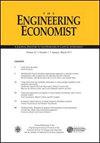排放交易系统规定下资产车队的最佳更换、改造和管理
IF 1
4区 经济学
Q4 BUSINESS
引用次数: 2
摘要
摘要本文提出了一个资产车队的并行替换和改进模型,以最大限度地减少经济成本和温室气体排放,其中排放受到排放交易系统(也称为总量管制和交易)的限制。拥有这些资产的公司可以选择使用、储存、改进或抢救这些资产。资产考虑了不同的技术类型及其性能。公司可以选择从不同的技术中购买新资产和/或将现有资产改进为更高性能的类型。该模型考虑了将排放配额存入银行或在市场上进行交易的可能性。该模型应用于加拿大安大略省一支挖掘机车队的数据。该模型和本案例研究的结果可以帮助排放企业在受总量管制和交易监管的司法管辖区内同时管理其资产的排放和成本。本文章由计算机程序翻译,如有差异,请以英文原文为准。
Optimal Replacement, Retrofit, and Management of a Fleet of Assets under Regulations of an Emissions Trading System
Abstract This paper presents a model for parallel replacement and improvement for a fleet of assets to minimize both the economic costs and greenhouse gas (GHG) emissions where the emissions are limited by an emissions trading system also known as cap-and-trade. The firm which owns the assets has the options of using, storing, improving, or salvaging them. Different technological types and their performances have been considered for the assets. The firm has the option of purchasing new assets from varying technologies and/or improving its existing assets to a higher-performance type. The model considers the possibility of both banking the emission allowances or trading them in the market. The model was applied to data from a fleet of excavators in Ontario, Canada. The model and the findings of this case study could help emitter firms to simultaneously manage the emissions and costs of their assets in a jurisdiction regulated by cap-and-trade.
求助全文
通过发布文献求助,成功后即可免费获取论文全文。
去求助
来源期刊

Engineering Economist
ENGINEERING, INDUSTRIAL-OPERATIONS RESEARCH & MANAGEMENT SCIENCE
CiteScore
2.00
自引率
0.00%
发文量
14
审稿时长
>12 weeks
期刊介绍:
The Engineering Economist is a refereed journal published jointly by the Engineering Economy Division of the American Society of Engineering Education (ASEE) and the Institute of Industrial and Systems Engineers (IISE). The journal publishes articles, case studies, surveys, and book and software reviews that represent original research, current practice, and teaching involving problems of capital investment.
The journal seeks submissions in a number of areas, including, but not limited to: capital investment analysis, financial risk management, cost estimation and accounting, cost of capital, design economics, economic decision analysis, engineering economy education, research and development, and the analysis of public policy when it is relevant to the economic investment decisions made by engineers and technology managers.
 求助内容:
求助内容: 应助结果提醒方式:
应助结果提醒方式:


